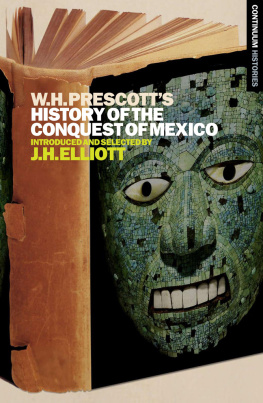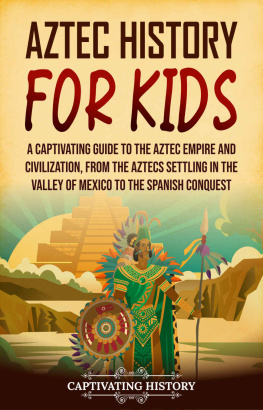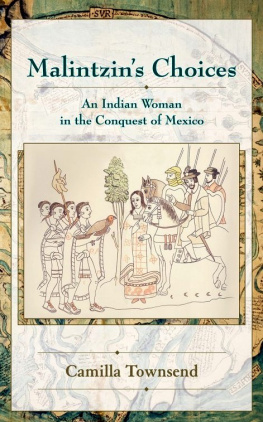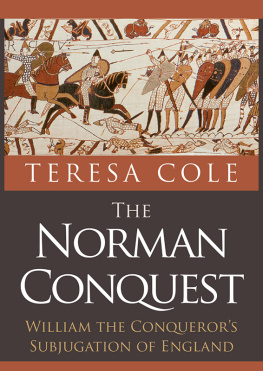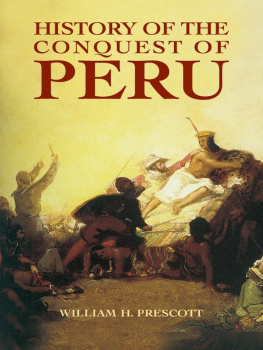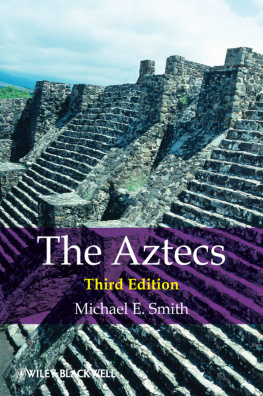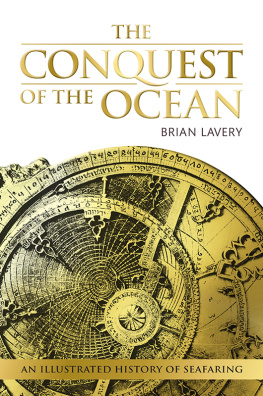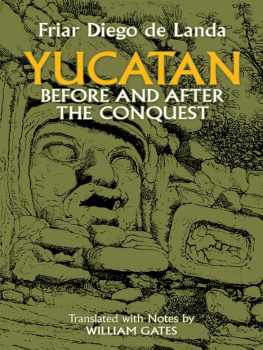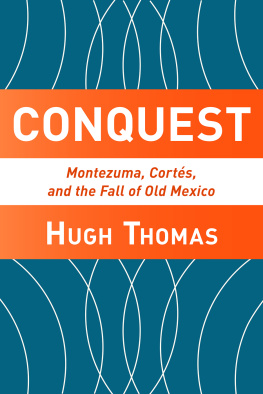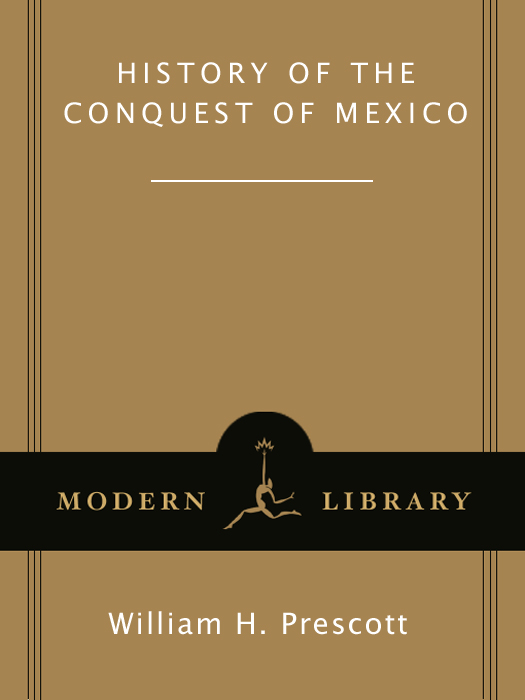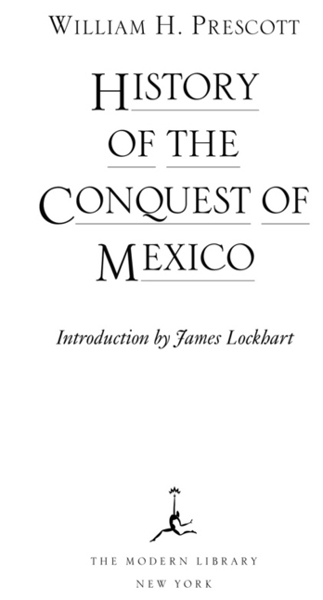Introduction copyright 2001 by James Lockhart
All rights reserved under International and Pan-American Copyright Conventions. Published in the United States by Modern Library, an imprint of The Random House Publishing Group, a division of Random House, Inc., New York, and simultaneously in Canada by Random House of Canada Limited, Toronto.
M ODERN L IBRARY and the T ORCHBEARER Design are registered trademarks of Random House, Inc.
LIBRARY OF CONGRESS CATALOGING-IN-PUBLICATION DATA
Prescott, William Hickling, 17961859.
History of the conquest of Mexico / William H. Prescott; with an
introduction by James Lockhart.
p. cm.
eISBN: 978-0-307-76976-3
1. MexicoHistoryConquest, 15191540. 2. Corts, Hernn, 14851547.
3. AztecsHistory16th century. 4. Indians of MexicoHistory
16th century. I. Title.
F1230 .P9366 2001
972.02dc21 2001044561
Modern Library website address:
www.modernlibrary.com
v3.1
W ILLIAM H. P RESCOTT
William Hickling Prescott, the renowned American historian who chronicled the rise and fall of the Spanish empire, was born in Salem, Massachusetts, on May 4, 1796. His grandfather had commanded colonial forces at the Battle of Bunker Hill during the American Revolution; his father was a highly respected judge and philanthropist. Prescott was tutored in Latin and Greek by the rector of Trinity Church in Boston and entered Harvard in 1811. In a bizarre accident, Prescott was blinded in the left eye by a crust of bread thrown in a dining-hall fracas. He abandoned plans to study law but went on to graduate in 1814 having earned membership in Phi Beta Kappa. While traveling abroad the following year Prescott temporarily lost the sight in his right eye. With his vision permanently impaired, he aspired to the life of gentleman-scholar. Prescott launched a career as a man of letters in 1821 with an essay on Byron that appeared in the North American Review. Over the next two decades he contributed regularly to the prestigious Boston literary journal. His most important articles and reviews, including seminal pieces on the theory and practice of historical composition, were later collected in Biographical and Critical Miscellanies (1845) and Critical and Historical Essays (1850).
Under the influence of George Ticknor, a friend and mentor who taught European literature at Harvard, Prescott began learning Spanish in 1824. Engrossed by the history of Spain, he committed himself to tracing its development into a world power. Employing secretaries to read him manuscripts sent from Spanish archives, Prescott set about writing a work of sound scholarship that would also interest a general audience. A phenomenal memory allowed him to compose whole chapters in his mind during morning horseback rides. Later he recorded them on paper using a noctograph, a special stylus for the blind. More than a decade later he finished The History of the Reign of Ferdinand and Isabella the Catholic (1837), which enjoyed tremendous critical and popular success on both sides of the Atlantic.
Prescotts fame gained him entre into Spanish intellectual circles, greatly facilitating research on his next book, History of the Conquest of Mexico (1843), a sweeping account of Cortss subjugation of the Aztec people. Regarded simply from the standpoint of literary criticism, the Conquest of Mexico is Prescotts masterpiece, judged his biographer Harry Thurston Peck. More than that, it is one of the most brilliant examples which the English language possesses of literary art applied to historical narration. [Prescott] transmuted the acquisitions of laborious research into an enduring monument of pure literature. Pulitzer Prizewinning historian Daniel J. Boorstin agreed: The enduring interest in Prescotts Conquest of Mexico comes less from his engaging survey of Aztec civilization than from his genius for the epic. Though Prescott has been called the nations first scientific historian for his use of manuscript sources, he would live on as a creator of literature.
Prescott completed his pioneering study of Spanish exploits in the New World with the History of the Conquest of Peru (1847), a vivid chronicle of Pizarros tumultuous overthrow of the Inca empire. The Conquest of Peru represents an authors triumph over his materials, observed Donald G. Darnell, one of the historians several biographers. Prescott exploits to the fullest any opportunities for dramatic effects that history might provide him. The description of the Inca civilization, particularly its wealth, the precise explanation of the cause of the conflict between the conquerors, and the depiction of the Spanish characterthese together with the careful research, the sheer abundance of anecdotes, and the exploitation of primary materials all contribute to the historys continuing popularity.
Prescott devoted his final years to chronicling the decline of the Spanish empire. He published The Life of Charles the Fifth after His Abdication (1856), a continuation of William Robertsons The History of the Reign of the Emperor Charles the Fifth (1769), but only managed to finish the first three volumes of The History of the Reign of Philip the Second (185558). William H. Prescott died of a stroke at his home in Boston on January 29, 1859. In assessing his achievements, Daniel J. Boorstin wrote: One of Prescotts greatest feats as a scientific historian was to depict the scenes of his drama so vividly without ever having been therefor he never visited Spain, Mexico, or Peru. Prescott created from the rawest of raw material, laboring under physical handicaps and displaying a single-minded courage with few precedents in the annals of literature. He had to discover the landscape, conceive new heroes, and mark their own paths through time. The story of how he made his histories was itself a kind of epic.
C ONTENTS
BOOK I
I NTRODUCTIONVIEW OF THE A ZTEC C IVILIZATION
CHAPTER I
ANCIENT MEXICOCLIMATE AND PRODUCTSPRIMITIVE RACES
AZTEC EMPIRE
Extent of the Aztec TerritoryThe Hot RegionVolcanic SceneryCordillera of the AndesTable-land in the Days of the AztecsValley of MexicoThe ToltecsTheir Mysterious DisappearanceRaces from the North-westTheir HostilitiesFoundation of MexicoDomestic FeudsLeague of the Kindred TribesRapid Rise of MexicoProsperity of the EmpireCriticism on Veytias History
CHAPTER II
SUCCESSION TO THE CROWNAZTEC NOBILITYJUDICIAL SYSTEM
LAWS AND REVENUESMILITARY INSTITUTIONS
Election of the SovereignHis CoronationAztec NoblesTheir Barbaric PompTenure of Their EstatesLegislative PowerJudicial SystemIndependent JudgesTheir Mode of ProcedureShowy TribunalHieroglyphical PaintingsMarriage RitesSlavery in MexicoRoyal RevenuesBurdensome ImpostsPublic CouriersMilitary EnthusiasmAztec AmbassadorsOrders of KnighthoodGorgeous ArmorNational StandardsMilitary CodeHospitals for the WoundedInfluence of Conquest on a NationCriticism on Torquemadas HistoryAbb Clavigero
CHAPTER III
MEXICAN MYTHOLOGYTHE SACERDOTAL ORDERTHE TEMPLESHUMAN SACRIFICES
Systems of MythologyMythology of the AztecsIdeas of a GodSanguinary WargodGod of the AirMystic LegendsDivision of TimeFuture StateFuneral CeremoniesBaptismal RitesMonastic OrdersFasts and FlagellationAztec ConfessionalEducationof the YouthRevenue of the PriestsMexican TemplesReligious FestivalsHuman SacrificesThe Captives DoomCeremonies of SacrificeTorturing of the VictimSacrifice of InfantsCannibal BanquetsNumber of VictimsHouses of SkullsCannibalism of the AztecsCriticism on Sahaguns History


